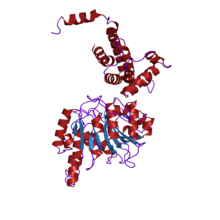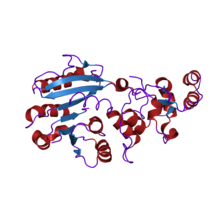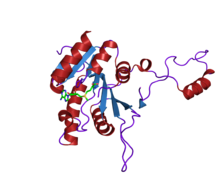DNAメチルトランスフェラーゼ
| N-6 DNA Methylase | |||||||||
|---|---|---|---|---|---|---|---|---|---|
 タイプI制限修飾系EcoKI Mタンパク質(M.EcoKI、EC 2.1.1.72) | |||||||||
| 識別子 | |||||||||
| 略号 | N6_Mtase | ||||||||
| Pfam | PF02384 | ||||||||
| Pfam clan | CL0063 | ||||||||
| InterPro | IPR003356 | ||||||||
| PROSITE | PDOC00087 | ||||||||
| |||||||||
| HsdM N-terminal domain | |||||||||
|---|---|---|---|---|---|---|---|---|---|
| 識別子 | |||||||||
| 略号 | HsdM_N | ||||||||
| Pfam | PF12161 | ||||||||
| |||||||||
| C-5 cytosine-specific DNA methylase | |||||||||
|---|---|---|---|---|---|---|---|---|---|
 ヒトのDNAメチルトランスフェラーゼホモログDNMT2の構造 | |||||||||
| 識別子 | |||||||||
| 略号 | DNA_methylase | ||||||||
| Pfam | PF00145 | ||||||||
| Pfam clan | CL0063 | ||||||||
| InterPro | IPR001525 | ||||||||
| PROSITE | PDOC00089 | ||||||||
| SCOP | 1hmy | ||||||||
| SUPERFAMILY | 1hmy | ||||||||
| CDD | cd00315 | ||||||||
| |||||||||
| DNA methylase | |||||||||
|---|---|---|---|---|---|---|---|---|---|
 Moraxella bovisのメチルトランスフェラーゼMboIIAの結晶構造 | |||||||||
| 識別子 | |||||||||
| 略号 | N6_N4_Mtase | ||||||||
| Pfam | PF01555 | ||||||||
| Pfam clan | CL0063 | ||||||||
| InterPro | IPR002941 | ||||||||
| PROSITE | PDOC00088 | ||||||||
| SCOP | 1boo | ||||||||
| SUPERFAMILY | 1boo | ||||||||
| |||||||||
DNAメチルトランスフェラーゼまたはDNAメチル基転移酵素、DNAメチル化酵素(英: DNA methyltransferase、略称: DNA MTase、DNMT)は、DNAへのメチル基の転移を触媒する酵素ファミリーである。DNAメチル化は幅広い生物学的機能を持つ。既知のDNAメチル基転移酵素はすべて、メチル基の供与体としてS-アデノシルメチオニンを利用する。
分類
[編集]基質
[編集]DNAメチル基転移酵素は、触媒する化学反応によって3つの異なるグループに分類される。
- m6Aメチル基転移酵素 - N6-メチルアデニンを形成(EC 2.1.1.72)
- m4Cメチル基転移酵素 - N4-メチルシトシンを形成(EC 2.1.1.113)
- m5Cメチル基転移酵素 - C5-メチルシトシンを形成(EC 2.1.1.37 )
m6A修飾を行うm6Aメチル基転移酵素(英語版)とm4C修飾を行うm4Cメチル基転移酵素(英語版)は、主に原核生物においてよく知られているが、m6Aメチル基転移酵素については真核生物にも豊富に存在することが近年示唆されている[1]。一方で、m5C修飾を行うm5Cメチル基転移酵素は真核生物の一部、具体的には一部の下等真核生物や高等植物の大部分、棘皮動物以降の動物に存在している。
m6Aメチル基転移酵素
[編集]m6Aメチル基転移酵素(N6アデニン特異的DNAメチル基転移酵素、A-MTase)はDNAのアデニンのN6位を特異的にメチル化する酵素である。A-MTaseは細菌の制限修飾系の3つのタイプでみられる。これらの酵素は対応する制限酵素と同じ配列特異性を持ち、DNA配列をメチル化することで自身のゲノムを制限酵素による分解から防いでいる。N末端部分にAsp/Asn-Pro-Pro-Tyr/Pheからなる保存されたモチーフを含んでおり、この領域は基質結合または触媒活性に関与している可能性がある[2][3][4][5]。m6AメチルトランスフェラーゼTaqI(M.TaqI)の構造は 2.4 Åの分解能で解かれており、分子は2つのドメインへ折りたたまれている。N末端の触媒ドメインには触媒部位と補酵素結合部位が含まれ、中心部の9つのストランドからなるβシートが5本のαヘリックスで囲まれた構造をしている。C末端のDNA認識ドメインは4つの小さなβシートと8つのαヘリックスによって形成される。N末端ドメインとC末端ドメインによって、基質DNAを収容する溝が形成される[6]。
タイプIの制限修飾系はR、M、Sの3つのポリペプチドから構成される。MサブユニットとSサブユニットはメチル基転移酵素を形成し、DNA認識配列の相補鎖の2つのアデニン残基をメチル化する。Rサブユニットの存在下では複合体はエンドヌクレアーゼとしても機能し、同じ部位に結合するがこの部位から幾分離れた位置でDNAの切断を行う。DNAが切断されるか修飾されるかは、標的配列のメチル化状態に依存している。標的部位が修飾されていない場合、DNAは切断される。標的部位の片側の鎖のみがメチル化(ヘミメチル化)されている場合、複合体は両方の鎖がメチル化されるようDNAの修飾を行う「維持型メチル基転移酵素」(maintenance methyltransferase)として機能する[7]。
m6Aメチル基転移酵素の中には、制限修飾系に関与していないオーファンメチル基転移酵素(orphan methyltransferase)と呼ばれるグループが存在する[8]。これらの酵素は、遺伝子発現や細胞周期を調節する役割がある。大腸菌Escherichia coliのEcoDam[9]やCaulobacter crescentus(英語版)のCcrM[10]は、このファミリーのメンバーとして性質がよく知られている。近年では、Clostridioides difficileのCamAが胞子やバイオフィルムの形成と宿主への適応に重要な機能的役割を果たすことが示されている[11]。
m4Cメチル基転移酵素
[編集]m4Cメチル基転移酵素(N4シトシン特異的DNAメチル基転移酵素)は、DNAのシトシンのN4位を特異的にメチル化する酵素である[5]。この酵素は原核生物のタイプII制限修飾系の構成要素として存在し、DNA配列を特異的に認識して配列中のシトシンをメチル化する。この作用によって、同じ配列を認識するタイプII制限酵素による分解からDNAが保護される。
m5Cメチル基転移酵素
[編集]m5Cメチル基転移酵素(C5シトシン特異的DNAメチル基転移酵素)は、DNA中のシトシンの5位を特異的にメチル化する酵素である[12][13][14]。哺乳類細胞では、シトシン特異的メチルトランスフェラーゼは特定のCpG配列をメチル化し、遺伝子発現と細胞分化を調節すると考えられている。細菌では制限修飾系の構成要素であり、DNA操作の重要なツールとしても利用されている[13][15]。HhaIメチルトランスフェラーゼ(M.HhaI)の構造は 2.5 Åの分解能で解かれている。触媒部位と補酵素結合部位を含む大きな触媒ドメインと小さなDNA認識ドメインの2つのドメインへと折りたたまれる[16]。
de novo型と維持型
[編集]de novoメチル基転移酵素(de novo methyltransferase)は、DNAの何らかの特徴を認識し、シトシンの新規のメチル化を行う。主に胚発生の初期に発現しており、遺伝子のメチル化パターンを確立する。
維持メチル基転移酵素(maintenance methyltransferase)は、一方の鎖が既にメチル化されたDNAにメチル基を付加する。生涯を通じて機能し、de novoメチル基転移酵素によって確立されたメチル化パターンの維持を行う。
哺乳類
[編集]哺乳類では3つのDNAメチル基転移酵素が同定されており、DNMT1[17]、DNMT3A[18]、DNMT3B[19]と命名されている。以前DNMT2という名称で知られていた酵素はDNAメチルトランスフェラーゼではないことが判明している(下を参照)。
DNMT3L[20]はDNMT3AとDNMT3Bと構造的に近縁でDNAメチル化に重要なタンパク質であるが、それ自身はメチル化活性を持たないようである。
DNMT1
[編集]DNMT1は哺乳類細胞に最も豊富に存在するDNAメチル基転移酵素であり、哺乳類の主要な維持メチルトランスフェラーゼであると考えられている。主にゲノム中のヘミメチル化されたCpGジヌクレオチドをメチル化する。メチル化されていない基質と比較してヘミメチル化DNAに対する活性はin vitroでは7–100倍高いが、それでも他のDNMTよりは高いde novoメチル化活性を持つ。ヒトの酵素はCpGジヌクレオチド対の3つの塩基、一方の鎖のCともう一方の鎖のCpGのみを認識する。このような基質の必要条件の緩さによって、DNA二本鎖がスリップして対合したような異常構造に対するde novoメチル化を維持メチル化と同程度に行うことが可能になっている[21]。他のm5Cメチルトランスフェラーゼと同様、二本鎖DNAのフリップアウトしたシトシンを認識し、求核攻撃機構によってメチル化を行う[22]。ヒトのがん細胞では、DNMT1はがん抑制遺伝子のde novoメチル化と維持メチル化の双方を担っている[23][24]。この酵素は約1620アミノ酸から構成される。最初の1100アミノ酸は調節ドメインを構成し、残りの残基が触媒ドメインを構成する。両者はグリシン-リジンのリピート配列によって連結されている。DNMT1の触媒機能にはどちらのドメインも必要である。
DNMT1には体細胞型のDNMT1、スプライスバリアントのDNMT1b、卵母細胞特異的なDNMT1oと呼ばれるアイソフォームが存在する。DNMT1oは卵母細胞の細胞質で合成されて貯蔵され、初期胚発生時に細胞核へ移行する。一方、体細胞型のDNMT1は体細胞組織の細胞核に常に存在する。
DNMT1を欠損した胚性幹細胞は生存可能であるが、メチル化DNAの比率やメチル基転移酵素活性は低くなる。Dnmt1をホモ欠損したマウスの胚は妊娠10–11日の段階で死亡する[25]。
TRDMT1
[編集]この酵素は原核生物と真核生物の双方のm5Cメチル基転移酵素との高い配列類似性を持ち、DNMT2と呼ばれていた。しかし2006年、この酵素はDNAのメチル化を行わず、アスパラギン酸のtRNAの38位をメチル化することが示された[26]。このメチル基転移酵素の名称は、DNMT2から生物学的機能をよりよく反映したTRDMT1(tRNA aspartic acid methyltransferase 1)へと変更された[27]。TRDMT1はヒトの細胞で初めて同定されたRNAシトシンメチルトランスフェラーゼである。
DNMT3
[編集]DNMT3はヘミメチル化されたCpGとメチル化されていないCpGを同率でメチル化することができるDNAメチル基転移酵素のファミリーである[28]。DNMT3の構造はDNMT1と類似しており、触媒ドメインに調節ドメインが結合した構造をしている。DNMT3はDNMT3A、3B、3Lという3つのメンバーが知られている。DNMT3AによるCpG配列のメチル化はDNMT1よりもかなり遅いが、DNMT3Bよりは速い[29]。非CpG配列に対する相対的活性はDNMT3AよりもDNMT3Bのほうが高く、両者の配列選択性には若干の差異が存在する[30]。DNMT3AとDNMT3Bはメチル化非依存的に遺伝子発現の抑制を媒介することができる。DNMT3Aはヘテロクロマチンタンパク質HP1、ヒストンメチル基転移酵素SUV39H1と相互作用する。これらはDNMT1とも相互作用し、DNAメチル化とヒストン修飾を直接連結している可能性がある[31]。
DNMT3LはDNAメチル基転移酵素モチーフを持っており、母親由来のゲノムインプリンティングの確立に必要であるが、メチル化活性は持たない[32]。DNMT3Lは、ゲノムインプリンティングが起こる配偶子形成の際に発現している。DNMT3Lの欠失によって、通常は母親由来のアレルからの発現が起こらない遺伝子でも両方のアレルから発現が起こるようになる[33]。DNMT3LはDNMT3A、DNMT3Bと相互作用し、核内で共局在している[34]。DNMT3Lはメチル化を行わないが、転写抑制に関与している可能性がある。
臨床的意義
[編集]阻害剤
[編集]DNMTファミリーは遺伝子発現にエピジェネティックな影響を与えるため、いくつかのDNMT阻害剤はがんの治療薬としての研究が行われている[35]。
- アザシチジン(商標名: Vidaza)は骨髄異形成症候群と急性骨髄性白血病(AML)に対する第III相試験が行われている。
- デシタビン(商標名: Dacogen)はAMLと慢性骨髄性白血病に対する第III相試験が行われている。EUでは2012年にAMLに対しする治療薬として承認された[36]。
- グアデシタビン(guadecitabine)は、AMLに対する第III相試験でプライマリーエンドポイント(主要評価項目)を達成しなかった。
出典
[編集]- ^ “Adenine methylation in eukaryotes: Apprehending the complex evolutionary history and functional potential of an epigenetic modification”. BioEssays 38 (1): 27–40. (January 2016). doi:10.1002/bies.201500104. PMC 4738411. PMID 26660621.
- ^ “Organization and sequence of the hsd genes of Escherichia coli K-12”. Journal of Molecular Biology 198 (2): 159–70. (November 1987). doi:10.1016/0022-2836(87)90303-2. PMID 3323532.
- ^ “The amino acid sequence of the eukaryotic DNA [N6-adenine]methyltransferase, M.CviBIII, has regions of similarity with the prokaryotic isoschizomer M.TaqI and other DNA [N6-adenine] methyltransferases”. Gene 74 (1): 253–9. (December 1988). doi:10.1016/0378-1119(88)90298-3. PMID 3248728.
- ^ “Evolution of type II DNA methyltransferases. A gene duplication model”. Journal of Molecular Biology 206 (2): 313–21. (March 1989). doi:10.1016/0022-2836(89)90481-6. PMID 2541254.
- ^ a b “Sequence motifs characteristic for DNA [cytosine-N4] and DNA [adenine-N6] methyltransferases. Classification of all DNA methyltransferases”. Gene 157 (1–2): 3–11. (May 1995). doi:10.1016/0378-1119(94)00783-O. PMID 7607512.
- ^ “Three-dimensional structure of the adenine-specific DNA methyltransferase M.Taq I in complex with the cofactor S-adenosylmethionine”. Proceedings of the National Academy of Sciences of the United States of America 91 (23): 10957–61. (November 1994). doi:10.1073/pnas.91.23.10957. PMC 45145. PMID 7971991.
- ^ “Mutations that confer de novo activity upon a maintenance methyltransferase”. Journal of Molecular Biology 221 (2): 431–40. (September 1991). doi:10.1016/0022-2836(91)80064-2. PMID 1833555.
- ^ Adhikari, Satish; Curtis, Patrick D. (2016-09-01). “DNA methyltransferases and epigenetic regulation in bacteria”. FEMS Microbiology Reviews 40 (5): 575–591. doi:10.1093/femsre/fuw023. ISSN 0168-6445. PMID 27476077.
- ^ Chahar, Sanjay; Elsawy, Hany; Ragozin, Sergey; Jeltsch, Albert (January 2010). “Changing the DNA Recognition Specificity of the EcoDam DNA-(Adenine-N6)-Methyltransferase by Directed Evolution”. Journal of Molecular Biology 395 (1): 79–88. doi:10.1016/j.jmb.2009.09.027. PMID 19766657.
- ^ Maier, Johannes A. H.; Albu, Razvan F.; Jurkowski, Tomasz P.; Jeltsch, Albert (2015-12-01). “Investigation of the C-terminal domain of the bacterial DNA-(adenine N6)-methyltransferase CcrM”. Biochimie 119: 60–67. doi:10.1016/j.biochi.2015.10.011. ISSN 0300-9084. PMID 26475175.
- ^ Oliveira, Pedro H.; Ribis, John W.; Garrett, Elizabeth M.; Trzilova, Dominika; Kim, Alex; Sekulovic, Ognjen; Mead, Edward A.; Pak, Theodore et al. (2019-11-25). “Epigenomic characterization of Clostridioides difficile finds a conserved DNA methyltransferase that mediates sporulation and pathogenesis” (英語). Nature Microbiology. doi:10.1038/s41564-019-0613-4. ISSN 2058-5276.
- ^ “Sequence motifs specific for cytosine methyltransferases”. Gene 74 (1): 261–5. (December 1988). doi:10.1016/0378-1119(88)90299-5. PMID 3248729.
- ^ a b “The DNA (cytosine-5) methyltransferases”. Nucleic Acids Res. 22 (1): 1–10. (January 1994). doi:10.1093/nar/22.1.1. PMC 307737. PMID 8127644.
- ^ “Cytosine-specific type II DNA methyltransferases. A conserved enzyme core with variable target-recognizing domains”. J. Mol. Biol. 206 (2): 305–12. (March 1989). doi:10.1016/0022-2836(89)90480-4. PMID 2716049.
- ^ Cheng X (February 1995). “DNA modification by methyltransferases”. Curr. Opin. Struct. Biol. 5 (1): 4–10. doi:10.1016/0959-440X(95)80003-J. PMID 7773746.
- ^ “Crystal structure of the HhaI DNA methyltransferase complexed with S-adenosyl-L-methionine”. Cell 74 (2): 299–307. (July 1993). doi:10.1016/0092-8674(93)90421-L. PMID 8343957.
- ^ “Symbol report for DNMT1”. www.genenames.org. 2020年3月11日閲覧。
- ^ “Symbol report for DNMT3A”. www.genenames.org. 2020年3月11日閲覧。
- ^ “Symbol report for DNMT3B”. www.genenames.org. 2020年3月11日閲覧。
- ^ “Symbol report for DNMT3L”. www.genenames.org. 2020年3月11日閲覧。
- ^ “Stalling of Human DNA (Cytosine-5) Methyltransferase at Single Strand Conformers form a Site of Dynamic Mutation”. Journal of Molecular Biology 275 (1): 67–79. (1998). doi:10.1006/jmbi.1997.1430. PMID 9451440.
- ^ “Mechanism of human methyl-directed DNA methyltransferase and the fidelity of cytosine methylation”. Proceedings of the National Academy of Sciences of the United States of America 89 (10): 4744–4748. (1992). doi:10.1073/pnas.89.10.4744. PMC 49160. PMID 1584813.
- ^ “De novo CpG Island Methylation in Human Cancer Cells”. Cancer Research 66 (2): 682–692. (2006). doi:10.1158/0008-5472.CAN-05-1980. PMID 16423997.
- ^ “Differential Requirement for DNA Methyltransferse 1 In Maintaining Cancer Cell Gene Promoter Hypermethylation”. Cancer Research 66 (2): 729–735. (2006). doi:10.1158/0008-5472.CAN-05-1537. PMID 16424002.
- ^ “Targeted Mutation of the DNA Methyltransferase Gene Results in Embryonic Lethality”. Cell 69 (6): 915–926. (1992). doi:10.1016/0092-8674(92)90611-F. PMID 1606615.
- ^ “Methylation of tRNAAsp by the DNA Methyltransferase Homolog Dnmt2”. Science 311 (5759): 395–398. (2006). doi:10.1126/science.1120976. PMID 16424344.
- ^ “TRDMT1 tRNA aspartic acid methyltransferase 1 (Homo sapiens)”. Entrez Gene. NCBI (2010年11月1日). 2010年11月7日閲覧。
- ^ Okano, M.; Xie, S.; Li, E. (1998-07). “Cloning and characterization of a family of novel mammalian DNA (cytosine-5) methyltransferases”. Nature Genetics 19 (3): 219–220. doi:10.1038/890. ISSN 1061-4036. PMID 9662389.
- ^ He, Shikun; Yiu, Glenn; Zhou, Peng; Chen, Dong Feng (2013-01-01). Ryan, Stephen J.; Sadda, SriniVas R.; Hinton, David R. et al.. eds (英語). Retina (Fifth Edition). London: W.B. Saunders. pp. 642–651. doi:10.1016/b978-1-4557-0737-9.00033-3. ISBN 978-1-4557-0737-9
- ^ Suetake, Isao; Miyazaki, Junko; Murakami, Chikako; Takeshima, Hideyuki; Tajima, Shoji (2003-06). “Distinct enzymatic properties of recombinant mouse DNA methyltransferases Dnmt3a and Dnmt3b”. Journal of Biochemistry 133 (6): 737–744. doi:10.1093/jb/mvg095. ISSN 0021-924X. PMID 12869530.
- ^ Fuks, François; Hurd, Paul J.; Deplus, Rachel; Kouzarides, Tony (2003-05-01). “The DNA methyltransferases associate with HP1 and the SUV39H1 histone methyltransferase”. Nucleic Acids Research 31 (9): 2305–2312. doi:10.1093/nar/gkg332. ISSN 1362-4962. PMC 154218. PMID 12711675.
- ^ “DNMT3L DNA methyltransferase 3 like [Homo sapiens (human) - Gene - NCBI]”. www.ncbi.nlm.nih.gov. 2020年3月14日閲覧。
- ^ Bourc'his, D.; Xu, G. L.; Lin, C. S.; Bollman, B.; Bestor, T. H. (2001-12-21). “Dnmt3L and the establishment of maternal genomic imprints”. Science (New York, N.Y.) 294 (5551): 2536–2539. doi:10.1126/science.1065848. ISSN 0036-8075. PMID 11719692.
- ^ Hata, Kenichiro; Okano, Masaki; Lei, Hong; Li, En (2002-04). “Dnmt3L cooperates with the Dnmt3 family of de novo DNA methyltransferases to establish maternal imprints in mice”. Development (Cambridge, England) 129 (8): 1983–1993. ISSN 0950-1991. PMID 11934864.
- ^ Mack GS (2010). “To selectivity and beyond”. Nat. Biotechnol. 28 (12): 1259–66. doi:10.1038/nbt.1724. PMID 21139608.
- ^ “EC Approves Marketing Authorization Of DACOGEN For Acute Myeloid Leukemia”. (2012年9月28日) 28 September 2012閲覧。
関連文献
[編集]- Smith SS (1994). “Biological implications of the mechanism of action of human DNA (cytosine-5)methyltransferase”. Prog. Nucleic Acid Res. Mol. Biol.. Progress in Nucleic Acid Research and Molecular Biology 49: 65–111. doi:10.1016/s0079-6603(08)60048-3. ISBN 9780125400497. PMID 7863011.
- “Mammalian DNA (cytosine-5) methyltransferases and their expression”. Clin. Immunol. 109 (1): 6–16. (2003). doi:10.1016/S1521-6616(03)00204-3. PMID 14585271.
- “Eukaryotic cytosine methyltransferases”. Annu. Rev. Biochem. 74: 481–514. (2005). doi:10.1146/annurev.biochem.74.010904.153721. PMID 15952895.
- Svedruzić ZM (2008). “Mammalian cytosine DNA methyltransferase Dnmt1: enzymatic mechanism, novel mechanism-based inhibitors, and RNA-directed DNA methylation”. Curr. Med. Chem. 15 (1): 92–106. doi:10.2174/092986708783330700. PMID 18220765.
関連項目
[編集]- メチルトランスフェラーゼ
- DNAメチル化
- PRMT4経路
外部リンク
[編集]Text is available under the CC BY-SA 4.0 license; additional terms may apply.
Images, videos and audio are available under their respective licenses.
